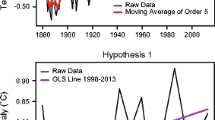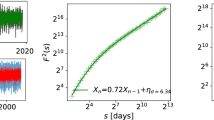Abstract
The unit root testing within a breaking trend framework for global and hemispheric temperatures of Gay-Garcia, Estrada and Sánchez Clim Chang 94:333–349, 2009 is extended in two directions: first, the extended HadCRUT3 temperature series from Brohan et al. J Geophys Res 111:D12106, 2006 are used and, second, new breaking trend estimators and unit root tests are employed, along with direct modelling of breaking trend and unit root processes for the series. Some differences to the results of Gay-Garcia et al. are found: break dates are shifted to 1976 for global and northern hemisphere temperatures and to 1964 for the southern hemisphere. Although the results are somewhat ambiguous, global and northern hemisphere temperatures are probably best modelled by unit root processes with a break in drift, while southern hemisphere temperatures follow a breaking trend process with stationary fluctuations about this trend. Irrespective of the models selected, there is little evidence of trend warming before the breaks, i.e., until the third quarter of the 20th century, and after the breaks northern hemisphere and global trend temperatures warm quicker than in the southern hemisphere, the range being between 0.01 and 0.02 °C per annum.


Similar content being viewed by others
Notes
The new data are currently available at http://hadobs.metoffice.com/hadcrut3/diagnostics/index.html.
David Harvey kindly provided the Gauss programs on which these calculations are based.
References
Brohan P, Kennedy JJ, Harris I, Tett SFB, Jones PD (2006) Uncertainty estimates in regional and global temperature changes: a new dataset from 1850. J Geophys Res 111:D12106
Cavaliere G, Georgiev I (2007) Testing for unit roots in autoregressions with multiple level shifts. Econ Theory 23:1162–1215
Cavaliere G, Harvey DI, Leybourne SJ, Taylor AMR (2011) Testing for unit roots in the presence of a possible break in trend and non-stationary volatility. Econ Theory 27:957–991
Elliott G, Rothenberg TJ, Stock JH (1996) Efficient tests for an autoregressive unit root. Econometrica 64:813–836
Estrada F, Gay C, Sànchez A (2010) A reply to “Does temperature contain a stochastic trend? Evaluating conflicting statistical results” by Kaufmann et al. Clim Chang 101:407–414
Gay-Garcia C, Estrada F, Sànchez A (2009) Global and hemispheric temperatures revisited. Clim Chang 94:333–349
Harris D, Harvey DI, Leybourne SJ, Taylor AMR (2009) Testing for a unit root in the presence of a possible break in trend. Econ Theory 25:1545–1588
Harvey DI, Mills TC (2001) Modelling global temperature trends using cointegration and smooth transitions. Stat Model 1:143–159
Harvey DI, Leybourne SJ, Taylor AMR (2010) The impact of the initial condition on robust tests of a linear trend. J Time Ser Anal 31:292–302
Kapetanios G (2005) Unit-root testing against the alternative hypothesis of up to m structural breaks. J Time Ser Anal 26:123–133
Kaufmann RK, Stern DI (1997) Evidence for human influence on climate from hemispheric temperature relations. Nature 388:39–44
Kaufmann RK, Kauppi H, Stock JH (2010) Does temperature contain a stochastic trend? Evaluating conflicting statistical results. Clim Chang 101:395–495
Kim D, Perron P (2009) Unit root tests allowing for a break in the trend function at an unknown time under both the null and alternative hypotheses. J Econ 148:1–13
Mills TC (2010) Skinning a cat: alternative models of representing temperature trends. Clim Chang 101:415–426
Perron P (1997) Further evidence of breaking trend functions in macroeconomic variables. J Econ 80:355–385
Perron P, Qu Z (2007) A simple modification to improve the finite sample properties of Ng and Perron’s unit root tests. Econ Lett 94:12–19
Perron P, Rodriguez G (2003) GLS detrending, efficient unit root tests and structural change. J Econ 115:1–27
Perron P, Yabu T (2009) Testing for shifts in trend with an integrated stationary noise component. J Bus Econ Stat 27:369–396
Perron P, Zhu X (2005) Structural breaks with deterministic and stochastic trends. J Econ 129:65–119
Vogelsang TJ, Perron P (1998) Additional tests for a unit root allowing the possibility of breaks in the trend function. Int Econ Rev 39:1073–1100
Author information
Authors and Affiliations
Corresponding author
Rights and permissions
About this article
Cite this article
Mills, T.C. Breaks and unit roots in global and hemispheric temperatures: an updated analysis. Climatic Change 118, 745–755 (2013). https://doi.org/10.1007/s10584-012-0672-5
Received:
Accepted:
Published:
Issue Date:
DOI: https://doi.org/10.1007/s10584-012-0672-5




